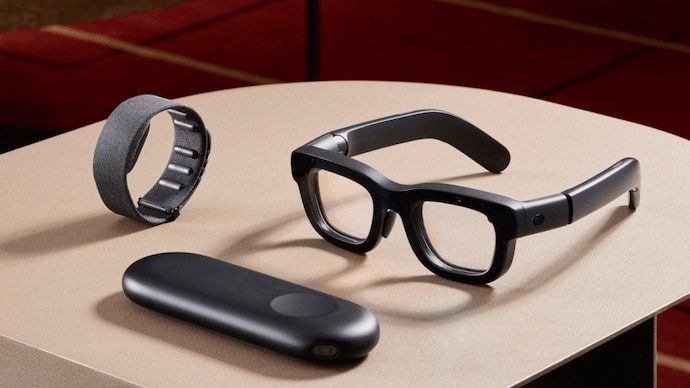Meta unveils futuristic Orion AR glasses, which will let users project digital images onto the real world
Meta Orion is designed to seamlessly blend all digital content with your view of the physical world. It is equipped with AI voice assistance, hand-tracking, eye-tracking, and a wrist-based neural interface that allows users to control functions using brain signals.
Listen to the story

During Meta Connect 2024, the company introduced its first AR glasses, called Orion. These glasses revolutionize display technology with silicon-carbide architecture, allowing holographic projections of different dimensions to blend with the physical environment. Showcasing the features of Orion, CEO Mark Zuckerberg said that the glasses will be equipped with AI voice assistance, hand-tracking, eye-tracking, and a wrist-based neural interface that allows users to control functions using brain signals. It seems that Meta Orion is designed to take over smartphones in the future.
Unlike previous Ray-Ban smartglasses, Orion combines real-world visuals with digital elements through advanced AR capabilities. Let’s dig deeper.

Meta’s Orion AR glasses
Turning imagination into reality, Orion is the kind of face computer we’re seeing with Marvel’s Iron Man. Orion has the largest field of view in the smallest AR glasses ever. It is capable of unlocking many high-level functions that have never been seen before. From multitasking windows and large-screen entertainment to real-size holograms of people – all digital content that can seamlessly blend with your view of the physical world. Meta also emphasizes that the glasses are lightweight and versatile, suitable for both indoor and outdoor use, enabling face-to-face contact even from a distance.
But the special thing here is that these smart glasses look and feel just like regular glasses. Unlike MR headsets or other AR glasses, these glasses have completely transparent lenses. So, you can still see other people’s eyes and expressions.

Talking about the features, Onion is deeply integrated with Meta AI. It understands what you are looking at in the physical world and can help you with useful visualizations. For example, you can open your refrigerator and ask for a recipe based on what is inside. Or make a video call to a friend while adjusting the digital family calendar while washing dishes.

Orion allows you to make hands-free video calls to interact with friends and family in real time, and you can stay connected on WhatsApp and Messenger to view and send messages. With the introduction of the Meta Orion glasses, you won’t have to take out your phone, unlock it, find the right app and tell your friend you’re going to be late for dinner – you can do it all through your glasses.
The Orion system consists of three parts: a “neural wristband” to control them; and a wireless block that resembles a large battery pack for a phone. When standalone, the glasses depend on proximity to the puck (about 12 feet) for full functionality.
Meta’s latest invention, Orion, looks great on paper and even during demos, but the hardest part is making it a part of everyday life. Meta aims to ship its first commercial AR glasses to consumers in 2027.
Quest 3S: Meta’s entry-level MR headset
Meta has also introduced the Quest 3S—the entry-level version of its Quest line of mixed-reality (MR) headsets. During Meta Connect 2024, the company revealed that the Quest 3S will come in two storage variants: 128GB and 256GB. It also revealed that the lower variant will be priced at $299.99 (roughly Rs. 25,000) and the higher one will cost $399.99 (roughly Rs. 33,000).

The Quest 3S uses the Qualcomm Snapdragon XR2 Gen 2 chipset. The processor is the same as its predecessor Meta Quest 3 launched last year. The latest Meta MR headset has twice the graphical performance of the Meta Quest 2. It also has a Fresnel lens and a slimmer design than the Quest 2. It also has two RGB cameras and an action button to activate the pass through mode, allowing you to view virtual objects in your meatspace.
The Quest 3S will hit the market on October 15. With the launch, the company is discontinuing its older Quest 2 and high-end Quest Pro devices, while also reducing the price of the more powerful Quest 3, launched last year, from $649.99 to $499.99 (roughly Rs. 42,000).




